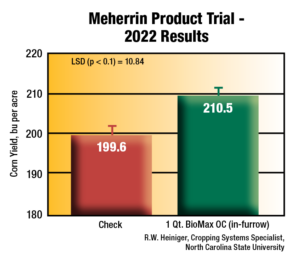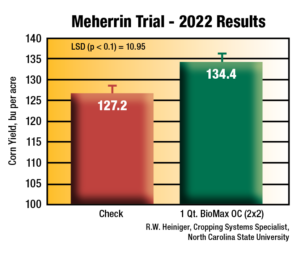Put Soil Microbes to Work for You
Put Soil Microbes to Work for You
Soil contains a treasure trove of microorganisms that work to break down residue, manure, and other organic material, returning their nutrients back to the soil for plants to use again. In natural areas such as forests and meadows, this continual recycling keeps the nutritional ecosystem in sync. In modern cropping systems, however, where the focus is on yield and nutrients are removed with the harvest, it is essential to add nutritional inputs each year. But that doesn’t mean you shouldn’t still take advantage of nutrient-releasing power of beneficial soil microorganisms, which can maximize availability and uptake of ground fertilizers while also giving growers the tools to save some fertilizer dollars and improve soil health and structure.
This is where Agro-K’s BioMax OC™ comes in. It contains a proprietary blend of enzymes and nutrients designed specifically for beneficial soil microorganisms, supporting and increasing their ability to reproduce and carry out their activity in the soil. By supercharging these microbes, it accelerates the conversion of unavailable nutrients such as phosphorus, nitrogen, manganese, zinc, sulfur and more into plant-usable forms.
BioMax OC is often applied at planting via in-furrow or 2×2. The OC formulation is designed to be compatible with orthophosphate fertilizers, so no additional pass is required. It can also be applied in early fall; both timings coincide with a natural increase in soil biological activity and root growth.
Jeff McClellan, Regional Sales Manager at Agro-K, says bacteria and fungi in the soil break the chemical bonds of tied-up phosphorus and other nutrients and use it themselves for their own living processes. But, when the microbes die, the nutrients are released back into the soil.
“For example, we’ve done work in 2022 with Dr. R.W. Heiniger at North Carolina State University on corn fields that test relatively high for phosphorus levels, but the plants still respond to phosphorus applications,” McClellan says. “That tells us the phosphorus is tied up. The challenge is to release that phosphorus that is already in the soil.”
Data from these trials show increased yields when BioMax OC is applied at planting. Applied in-furrow with starter fertilizer, the BioMax OC field yielded 210.5 bu/ac compared to 199.6 bu/ac in the field with starter fertilizer alone. BioMax OC was also applied 2×2 with starter fertilizer, and that field yielded an additional 7.6 bu/ac compared with the field with starter fertilizer alone. None of the fields had any additional fertilizer applied the rest of the season.
“We’ve been able to see some pretty dramatic differences in the availability of phosphorus in the soil,” McClellan says. “We’ve also seen a significant increase in soil biological activity.”
“It’s interesting to note that none of the nutrients in the soil in the BioMax OC fields went below what was adequate for the crop,” says Tim Wood, Southeast Agronomic Technical Representative for Agro-K. “The soil microbes were continually reproducing and releasing nutrients into the soil consistently through the season.”
Wood also says uniformity of germination was noticeably better in the BioMax OC fields, although there is no provable connection. BioMax OC does support root health by increasing populations of beneficial mycorrhizae, which are known to improve soil structure and increase the ability of roots to absorb moisture and nutrients.
The trials at North Carolina State are being replicated this season. In addition to corn, BioMax OC is recommended for row crops like soybeans, peanuts, wheat, and cotton. It can be applied via irrigation systems, band spraying or in-furrow.
Releasing Nutrients from Residue
While BioMax OC is specifically formulated for microbial populations that release nutrients, Agro-K’s Bio-Mulch™ is designed for microorganisms that feed on cellulose and lignin. Crop residue can be a headache after harvest, so accelerating its breakdown and digestion before the next season is a priority for farmers – especially in low-tillage or no-tillage cropping systems. Modern corn hybrids are tougher to break down, and higher planting density means even more residue.
“Bio-Mulch provides the food source needed by the specific microbes that break down lignin,” says Rob Ford, Midwest Sales Manager at Agro-K. “It’s a nutrient solution for the microbes that supercharges their growth. We feed them and increase the population, and they do their work faster.”
Breaking down the residue also results in nutrients being released into the soil, especially nitrogen. And, by releasing nitrogen into the soil in time for the start of the next growing season means it is there when the young plants need it. Some growers have found they can reduce their nitrogen applications as a result.
Chad Ralphs, Manager of CSC Farms near Jerome, Idaho, says he has reduced his nitrogen applications on potatoes after trialing Bio-Mulch. “The first year I put it on about 300 acres of sweet corn, which produces even more stubble,” he says. “During the following year, we saw a little bit of corn material, but it did a good job of breaking down the sweet corn. Then we studied petiole samples and saw a real jump in nitrogen compared with the untreated acres. So, I didn’t put any nitrogen on those Bio-Mulch acres.”
Bio-Mulch can be mixed with water and sprayed on residue, or it can be impregnated onto fall fertilizer. It can even be applied by air to standing corn just before harvest as it leaves no harmful residue and has an excellent worker safety profile.
Neither Bio-Mulch nor BioMax contain living organisms and have a long shelf life.


